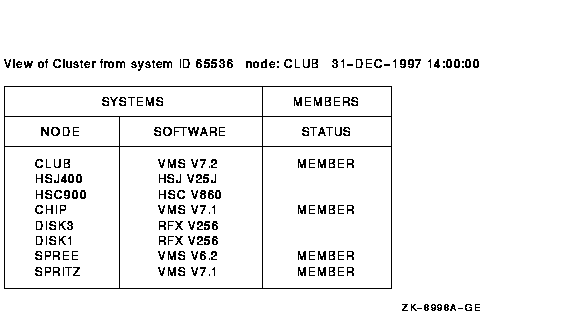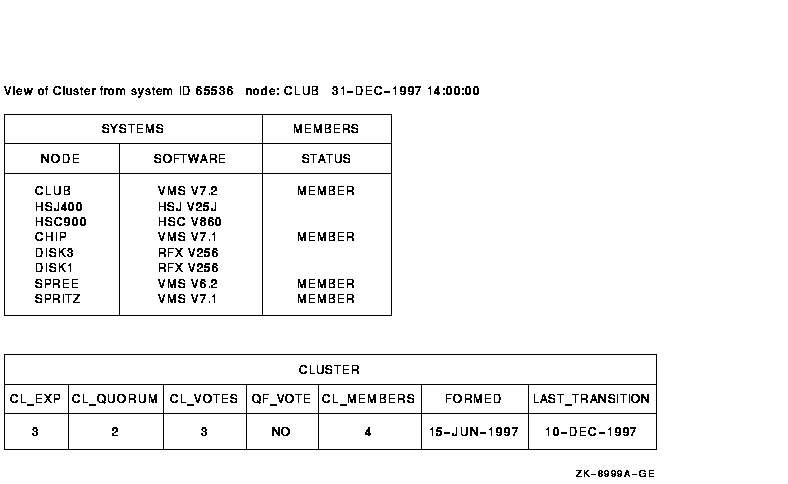HP OpenVMS Systems Documentation |
OpenVMS System Manager's Manual
22.1.2 Clusterwide System ManagementOnce any system is installed, you must decide how to manage users and resources for maximum productivity and efficiency while maintaining the necessary security. OpenVMS Cluster systems provide the flexibility to distribute users and resources to suit the needs of the environment. OpenVMS Cluster system resources can also be easily redistributed as needs change. Even with the vast number of resources available, you can manage the cluster configuration as a single system. You have several tools and products to help you manage your cluster as a unified entity. The following utilities are provided with the operating system:
System Management Applications
The following products are not provided with the operating system:
+VAX specific ++Alpha specific
You can find additional information about these system management tools
in the appropriate product documentation.
Compaq DECamds is a real-time monitoring, diagnostic, and correction tool that assists system managers to improve OpenVMS system and OpenVMS Cluster availability. DECamds can help system programmers and analysts target a specific node or process for detailed analysis, and can help system operators and service technicians resolve hardware and software problems. DECamds simultaneously collects and analyzes system data and process data from multiple nodes and displays the output on a DECwindows Motif display. Based on the collected data, DECamds analyzes, detects, and proposes actions to correct resource and denial issues in real-time.
For more information, refer to the DECamds User's Guide.
The Show Cluster utility (SHOW CLUSTER) monitors nodes in an OpenVMS Cluster system. You can use the utility to display information about cluster activity and performance. The following sections describe the Show Cluster utility and explain how to perform these tasks:
22.3.1 Understanding SHOW CLUSTERYou can display SHOW CLUSTER information on your terminal screen or send it to a device or a file. You can use SHOW CLUSTER interactively, with command procedures, or with an initialization file in which you define default settings. Because this utility is installed with the CMKRNL privilege, SHOW CLUSTER requires no special privilege. SHOW CLUSTER information includes approximately 100 fields of data. You can customize the appearance of SHOW CLUSTER reports or define reports for access to often-needed data. SHOW CLUSTER reports are organized by classes and fields: You can add fields or classes to the default SHOW CLUSTER report. If you add a field or class to a report in a continuous display, SHOW CLUSTER automatically adds the new data to the display. Figure 22-1 shows a sample default SHOW CLUSTER report. The default report has two classes of information: SYSTEMS and MEMBERS. Below each class name are columns of fields that are associated with each class of information. Figure 22-1 SHOW CLUSTER Default Display 
Table 22-1 briefly describes the fields shown in Figure 22-1.
Over time, you can determine the most valuable classes and fields of data for your SHOW CLUSTER reports; you can then create a startup initialization file that establishes your default report formats. You can also build command procedures to use while running SHOW CLUSTER interactively. In this way, you can quickly reformat the report to show the data that is relevant for your installation. Startup initialization files and command procedures are explained later in this chapter. Because SHOW CLUSTER information includes many fields of data, the report can quickly extend beyond screen limits. Therefore, SHOW CLUSTER provides mechanisms to help you control the display of data, including the following mechanisms:
These mechanisms are described in detail in the OpenVMS System Management Utilities Reference Manual.
To use the Show Cluster utility, enter the SHOW CLUSTER command. If you specify the command without any qualifiers, however, SHOW CLUSTER simply displays a default report like that shown in Figure 22-1 and then displays the DCL prompt. In a continuous display, on the other hand, you can enter SHOW CLUSTER commands to control report output. You can, for example, add classes or fields to, or remove classes or fields from, reports. To invoke a continuous display, in which you can enter SHOW CLUSTER commands, use the /CONTINUOUS qualifier on the SHOW CLUSTER command. (SHOW CLUSTER command qualifiers are described in Section 22.3.2.3.) To invoke a continuous display of default SHOW CLUSTER report information, enter the following command:
SHOW CLUSTER then displays a default report. By default, SHOW CLUSTER updates the display every 15 seconds, with the changed data displayed in reverse video. After the default report, SHOW CLUSTER displays the following prompt:
(If the report extends below the limit of your terminal screen and you do not see the Command> prompt, you can press Return to display the prompt.) The following sections contain instructions for performing beginning SHOW CLUSTER tasks:
22.3.2.1 Viewing Information That Is Off the ScreenThe PAN command allows you to view the entire display by shifting your view of the display by column (horizontally) or by line (vertically).
To pan the display, perform one of the following actions:
By default, the SHOW CLUSTER arrow keys are set to the EDIT function. This means that, at the command prompt, you can perform command line editing that is similar to DCL line-mode editing. For example, the left arrow key moves the cursor to the left, and the up arrow key recalls the previous command. Refer to the OpenVMS User's Manual for information about DCL line-mode editing. When you use the SET FUNCTION command, you reset the function keys. After that, the arrow keys are redefined and DCL line-mode editing is disabled. To reset the arrow keys, enter the following command:
22.3.2.2 Exiting from a Continuous DisplayTo exit from a continuous display, perform one of the following actions:
22.3.2.3 Using SHOW CLUSTER QualifiersTable 22-2 briefly describes the qualifiers you can use with the SHOW CLUSTER command. The OpenVMS System Management Utilities Reference Manual contains reference information about these SHOW CLUSTER qualifiers.
In a continuous display, SHOW CLUSTER updates the display every 15 seconds by default. You can change this interval by using the /INTERVAL qualifier.
In this example, SHOW CLUSTER updates reports every 5 seconds,
displaying changed data in reverse video.
When you use the SHOW CLUSTER command, the resulting report is only part of the total information available. As shown in Figure 22-1, the default classes displayed are MEMBERS and SYSTEMS. Table 22-3 briefly describes all the classes you can display in SHOW CLUSTER reports. Refer to the OpenVMS System Management Utilities Reference Manual for details about these classes.
The following example shows how to add the CLUSTER class to a SHOW CLUSTER display:
Figure 22-2 shows the display that results from entering the ADD CLUSTER command. CLUSTER class is displayed below the default SHOW CLUSTER display. Figure 22-2 SHOW CLUSTER Display with CLUSTER Report 
For descriptions of the fields in the CLUSTER class, refer to the SHOW
CLUSTER section of the OpenVMS System Management Utilities Reference Manual.
Using SHOW CLUSTER commands, you can remove fields or classes from a
display, remove broadcast messages from the screen, and refresh the
screen display at any time. The following sections explain how to
perform these operations.
SHOW CLUSTER allows you to customize the display of data during a continuous session by entering various commands. The OpenVMS System Management Utilities Reference Manual describes SHOW CLUSTER commands in detail. Updating of the continuous display stops as soon as you enter input from the terminal keyboard. When you press the Return key after entering a command, updating of the display resumes until you enter another command.
By default, updating takes place at 15-second intervals. If you do not
enter a new command within 15 seconds, the command prompt disappears,
and two more lines of data take its place.
When you receive a system broadcast message during a continuous SHOW CLUSTER session, the message appears at the bottom of the screen. A multiline message fills as many lines of the screen as it needs. The last broadcast message you receive remains on the screen until you acknowledge it by entering input from the terminal in one of the following ways:
SHOW CLUSTER also displays error messages at the bottom of the screen.
For an explanation of the error messages, refer to the OpenVMS System Messages: Companion Guide for Help Message Users.
Ordinarily, a continuous display is updated or refreshed according to the default or specified interval time. SHOW CLUSTER scans the software databases, extracts and stores data for each field, displays any new or changed data, and updates the time. On Compaq and Compaq-compatible terminals, reverse video highlights any changed data. You can refresh the screen at any time by one of the following methods:
22.3.5 Formatting the Display of DataBecause SHOW CLUSTER allows you to include additional fields and classes, you can produce reports that overflow the physical limits of the terminal screen. However, you can use a number of methods to modify the display to meet your needs:
22.3.5.1 Removing Information from a ReportYou can remove certain fields or classes to reduce the width of a report to fit the limits of your screen. Also, certain fields or classes might not be important for your particular needs. You can also remove particular types of data to reduce the length of the report. Use the REMOVE command to remove fields or entire classes. To remove a field or class, use the appropriate qualifier with the REMOVE command. refer to the REMOVE commands in the SHOW CLUSTER section of the OpenVMS System Management Utilities Reference Manual for appropriate class names and qualifiers.
|